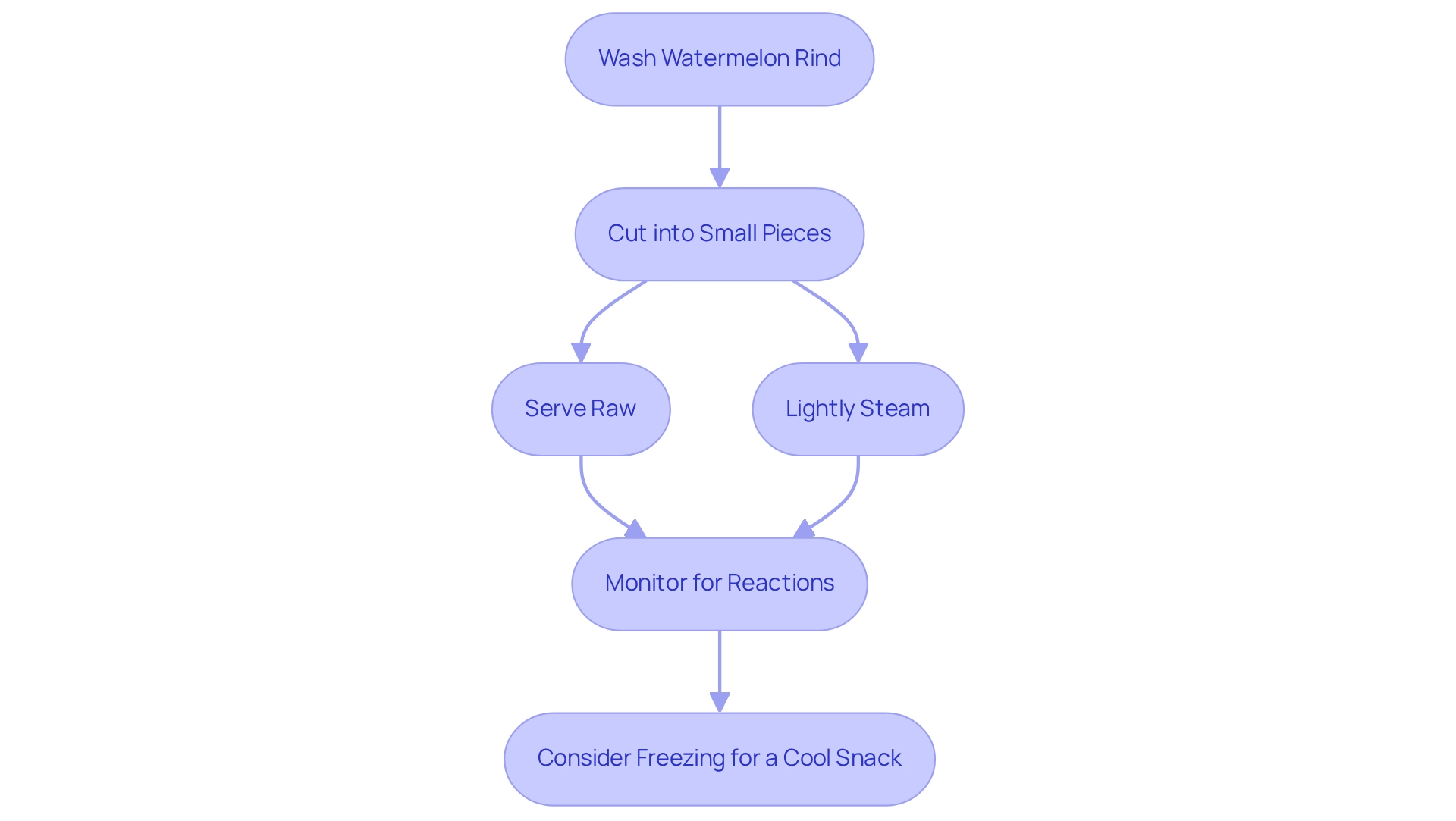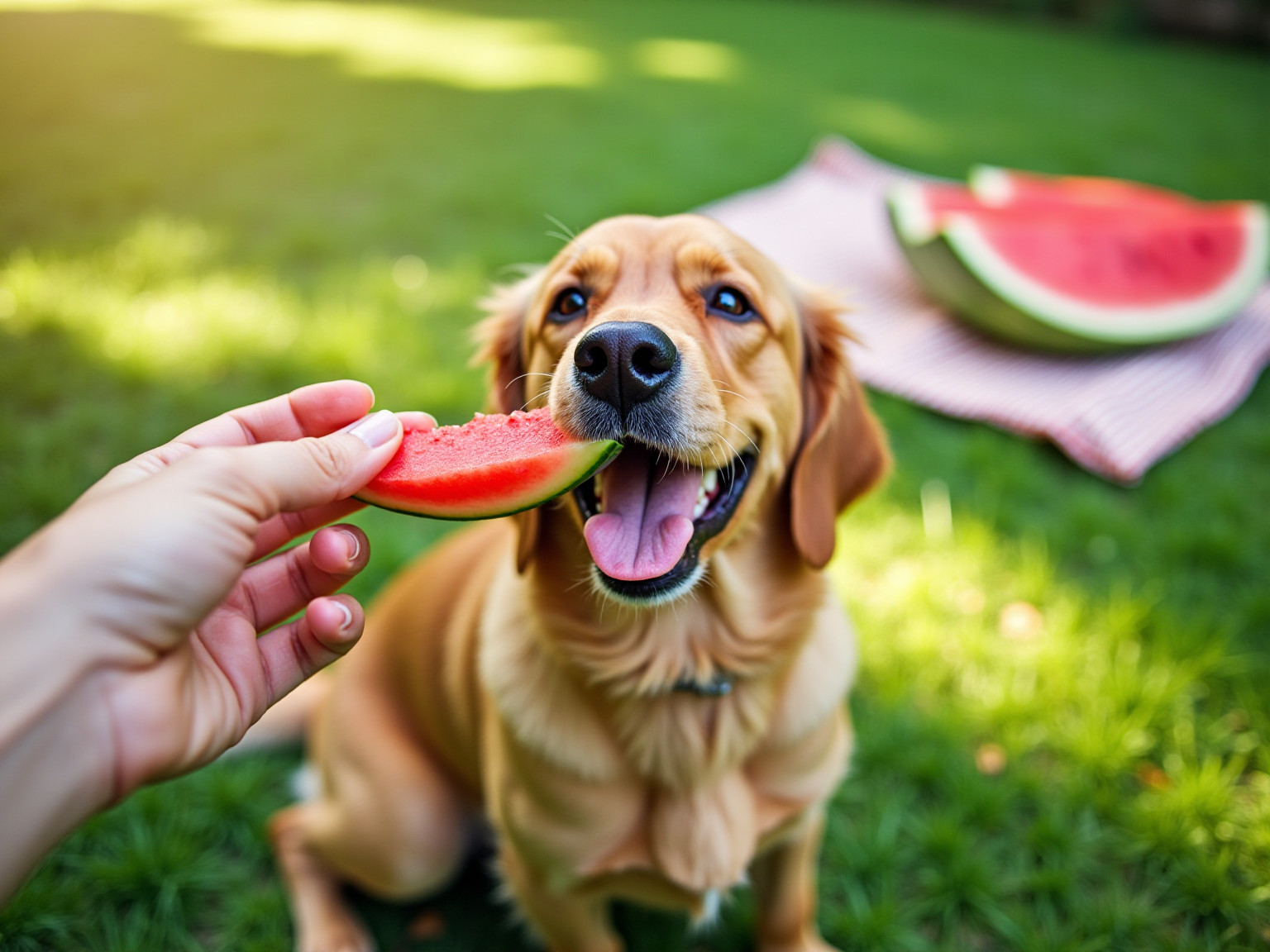Can Dogs Eat Watermelon Rind? Safe Preparation and Benefits
Overview
As a loving pet owner, you might wonder about the safety of sharing treats with your furry family members. Did you know that dogs can enjoy watermelon rind? However, it’s essential to prepare it safely to prevent choking hazards and gastrointestinal issues.
To ensure a nurturing environment for your pet, follow these steps:
- Cut the rind into small pieces.
- Keep a close eye for any adverse reactions.
Remember, treats like watermelon rind should make up no more than 10% of your dog’s daily diet. This simple guideline promotes their health and safety, allowing you to share delightful moments with your beloved companion.
Introduction
As devoted pet owners strive to provide their furry family members with healthy and enjoyable treats, watermelon rind shines as a delightful option that brings both nutritional benefits and hydration. However, before sharing this refreshing summer snack, it’s important to understand the potential risks and proper preparation methods to ensure safety.
From choking hazards to gastrointestinal concerns, knowing how to introduce watermelon rind into your dog’s diet can truly make a difference. This article explores the safety, nutritional advantages, and preparation techniques for watermelon rind, equipping you with the knowledge needed to share this delightful treat responsibly.
Understand the Safety of Watermelon Rind for Dogs
While watermelon skin is generally safe for your furry family members, it’s crucial for pet owners to understand the potential dangers, particularly when asking, can dogs eat watermelon rind? While it’s not harmful, the tough texture of the outer layer can pose choking risks or lead to gastrointestinal blockages if large pieces are consumed, raising the question of can dogs eat watermelon rind? To keep your pet safe, it’s essential to cut the skin into manageable sizes—about one-inch cubes are ideal—before offering it to your beloved companion. Additionally, always check the skin for any chemicals or pesticides that might be present, as these can be detrimental to your pet’s health.
Choking hazards in dogs are a significant concern, especially with tough items. It’s important to note that all treats combined, including watermelon rind, should make up no more than 10% of a dog’s total daily diet, highlighting the importance of moderation. While this fruit can serve as a refreshing treat, excessive consumption may lead to digestive upset, including diarrhea, bloating, or gas.
Veterinarians emphasize the importance of monitoring your dog for any symptoms of food allergies—such as hives, itching, vomiting, or diarrhea—and also advise on whether can dogs eat watermelon rind. If you notice any of these signs, it’s crucial to stop giving your dog that fruit and consult your veterinarian. Observing your pet for any negative reactions when introducing fruit skin is essential to ensure their safety and well-being, especially when considering if can dogs eat watermelon rind.
As Vishal Jain, a seasoned dog and cat parent, humorously points out, “Dogs can be like kids; they’ll eat anything if you let them!” This serves as a gentle reminder of the importance of supervision and moderation, especially when considering if can dogs eat watermelon rind. Furthermore, a case study titled “Is Watermelon Bad for Dogs?” reinforces that while this fruit is generally safe, moderation is key; treats should constitute no more than 10% of a dog’s daily diet, and owners should remain vigilant for any adverse reactions when introducing this fruit. By taking these precautions, you can safely enjoy sharing this delightful summer treat with your furry companions.
Explore the Nutritional Benefits of Watermelon Rind
When considering your furry family member’s diet, it’s important to ask, can dogs eat watermelon rind, as it is a nutrient-rich addition that offers several health benefits. It contains essential vitamins such as A, B6, and C, along with potassium and magnesium. These nutrients play a crucial role in supporting your dog’s immune system, promoting hydration, and enhancing overall health.
For instance, vitamin A is vital for vision and immune function, while B6 aids in protein metabolism and cognitive development. Vitamin C serves as an antioxidant, assisting in safeguarding cells from harm, and it raises the question of whether can dogs eat watermelon rind, as including it in your dog’s diet can be advantageous, especially since watermelon flesh is low in calories, making it a suitable choice for dogs on weight management plans.
However, it should be regarded as a supplement rather than a primary source of nourishment. Moderation is key; excessive peel can cause digestive distress. As Brian Krans notes, only about 5 percent of adults in the United States get the recommended daily value of fiber, underscoring the importance of fiber in your dog’s diet as well.
As with any new treat, it’s advisable to introduce the skin of the fruit gradually and observe your dog for any negative reactions. By doing so, you can ensure that your beloved pet enjoys the health benefits of this refreshing treat while maintaining a balanced diet.
Adventure Den, Vancouver’s premier dog daycare facility, emphasizes the importance of providing healthy treats in a safe environment, ensuring that pets receive the best care possible. Your furry friend deserves the best, and at Adventure Den, we’re dedicated to nurturing their health and happiness.
Learn How to Prepare and Serve Watermelon Rind Safely
To prepare the outer part of the melon for your furry family member, begin by thoroughly washing it to eliminate any pesticides or chemicals that might be present. This step is vital, as many human items can pose risks to dogs if not properly cleaned. Did you know that a quarter of pet owners would reduce expenses on specialty canine diets to save money? This makes affordable and safe snacks like watermelon peel an excellent choice, especially when considering the question of can dogs eat watermelon rind.
After washing, cut the watermelon rind into small, bite-sized pieces to minimize choking hazards, especially when considering if can dogs eat watermelon rind. You can serve it raw or lightly steamed, which softens the texture and makes it easier for your dog to chew, but you might wonder, can dogs eat watermelon rind? It’s essential to introduce new items gradually, allowing you to monitor for any adverse reactions. As Dr. Jo, a veterinarian, notes, “I’m so glad to hear this. I know you were very worried, so it’s wonderful to hear everything turned out okay,” emphasizing the importance of careful food introduction.
If your dog enjoys the outer layer, consider freezing small portions for a cool snack on warm days. This approach not only provides a tasty treat but also contributes to hydration, especially during the warmer months. Remember, monitoring dietary changes is crucial. Studies have shown the impact of sodium on dog health, reinforcing the need for careful preparation and observation. By nurturing your pet’s diet, you create a safe and loving environment for your beloved companion.

Identify Risks and Precautions When Feeding Watermelon Rind
While the outer part of the melon can be a safe snack for your furry family members, it’s important to consider if dogs can eat watermelon rind and observe some essential precautions. First and foremost, always remove any seeds, as they can pose a choking hazard or lead to intestinal blockages. Watch for indicators of such obstructions, which may include nausea, decreased appetite, and stomach discomfort. These signs are crucial to note when introducing new items like the outer part of a melon into your dog’s diet.
After adding watermelon rind to your dog’s meals, closely monitor them for any signs of digestive upset, such as diarrhea or lethargy. If your dog has a history of gastrointestinal issues, it’s wise to consult your veterinarian before introducing new foods. As noted by TopDog, if dogs are overweight, they may show an oval shape instead of the typical hourglass figure, highlighting the need for careful health monitoring.
Additionally, refrain from offering large amounts of peel at once, as this can lead to digestive discomfort. By keeping these precautions in mind, you can help ensure that your beloved pet can enjoy watermelon rind safely, answering the question of whether dogs can eat watermelon rind. Remember, your dog’s well-being is our priority, and with a little care, you can create a nurturing environment for them to thrive.
Conclusion
Watermelon rind can be a delightful and nutritious treat for your furry family members when prepared and served correctly. It offers essential vitamins and minerals that support overall health while providing hydration, making it an excellent addition to a balanced diet. However, as caring pet owners, it’s crucial to be aware of the potential risks associated with this treat, such as choking hazards and gastrointestinal issues. Proper preparation, including washing the rind thoroughly and cutting it into manageable pieces, can significantly reduce these risks.
Moderation is key when introducing watermelon rind into your dog’s diet. Treats should make up no more than 10% of a dog’s daily intake, and any signs of adverse reactions should prompt immediate consultation with a veterinarian. By following these guidelines, you can safely share this refreshing summer snack with your beloved pets while ensuring their well-being.
Ultimately, responsible pet ownership involves being informed about the foods shared with your dogs. By understanding the benefits and risks associated with watermelon rind, you can make informed decisions that enhance your pets’ diets and contribute to their health and happiness. Sharing this tasty treat can strengthen the bond between you and your pets, creating joyful moments while prioritizing safety and nutrition.
Frequently Asked Questions
Can dogs eat watermelon rind?
Yes, watermelon rind is generally safe for dogs, but it should be given in moderation and cut into manageable sizes, such as one-inch cubes, to prevent choking or gastrointestinal blockages.
What are the potential risks of feeding dogs watermelon rind?
The tough texture of watermelon rind can pose choking hazards or lead to gastrointestinal blockages if large pieces are consumed. Additionally, excessive consumption may cause digestive upset, including diarrhea, bloating, or gas.
How much of a dog’s daily diet should treats, including watermelon rind, make up?
Treats, including watermelon rind, should constitute no more than 10% of a dog’s total daily diet to ensure a balanced nutrition.
What should pet owners check for before giving watermelon rind to their dogs?
Pet owners should check the watermelon rind for any chemicals or pesticides that might be present, as these can be harmful to their pets.
What symptoms should pet owners monitor for when introducing watermelon rind to their dogs?
Pet owners should monitor for symptoms of food allergies, such as hives, itching, vomiting, or diarrhea. If any of these signs occur, it is important to stop giving the fruit and consult a veterinarian.
Why is it important to supervise dogs when giving them treats like watermelon rind?
Supervision is important because dogs may eat anything if left unsupervised, and it helps ensure their safety by preventing choking and monitoring for any adverse reactions.







